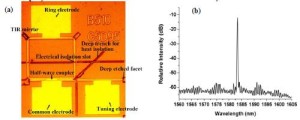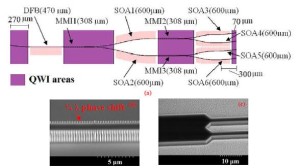By Dominic Siriani
Since it’s a topic that’s close to my heart, I enjoy the opportunity to see the latest work on semiconductor lasers whenever I come to CLEO. As always, I have been very impressed by all the work I’ve seen. And here I’d just like to highlight a couple of the many very impressive talks on this topic.

(a) Optical microscope image of the half-wave coupled rectangular ring-FP laser; (b) single mode emission with 44.5dB SMSR (Wu et al., CLEO 2014, STH1G.1).
One that struck me is work out of Zhejiang University in China. The standard for tunable diode lasers is typically distributed Bragg reflector edge emitting lasers, and they’re remarkable devices. They’re capable of producing single-mode lasers with high side mode suppression, and, using some special tricks, can be tuned over a very wide bandwidth. The researchers at Zhejiang University, however, are taking a different approach. By coupling a ring resonator to a Fabry-Perot cavity, they get excellent wavelength selectivity (up to 41 dB of SMSR). In addition, they can selectively tune the device over a very wide bandwidth, achieving 50 channels on a 50 GHz spacing. It looks like a very interesting alternative to the conventional device.
 Schematic of the device, (b) SEM picture of the first-order 50% duty cycle sidewall gratings with a 0.6 μm recess and λ/4 shift, (c) the MMI output side (Hou et al., CLEO 2014, STH1G.4).
Schematic of the device, (b) SEM picture of the first-order 50% duty cycle sidewall gratings with a 0.6 μm recess and λ/4 shift, (c) the MMI output side (Hou et al., CLEO 2014, STH1G.4).
Another interesting talk came out of University of Glasgow in the UK. These researchers have taking steps to monolithically scale up diode laser brightness. In order to do so, they have fabricated a DFB laser along with optical amplifiers. What’s special is that they’ve included intermediately a small tree of MMI splitters, so that an array of amplifiers exists at the device output. As a result, they get a coherently phased array with narrow divergence in the array direction and increased total power. The researchers demonstrated a four-element array, but they expressed hope for scaling up to even larger arrays in the near future. The nice thing is this sort of technology is scalable, and although there are some practical limits, there really aren’t any show-stopping fundamental limits to getting up to very high brightness sources.
These are just a couple of the remarkable talks on recent work in semiconductor lasers. Seeing as how fundamentally important diode lasers are to optical communications, sensing, research, and many other fields, it’s great to see the continued progress in this field.
Disclaimer: Opinions, interpretations, conclusions, and recommendations are those of the author and are not necessarily endorsed by the United States Government and MIT Lincoln Laboratory.
Posted: 12 June 2014 by
Dominic Siriani
| with 0 comments